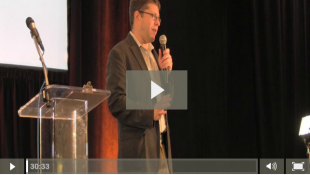
Improv at Work
John Windmueller, Organizational Training Manager, Washington Improv Theater
Duration: 30:33 mins
Discussion Questions:
How can you support one another better in the workplace?
Interactive: Partner up and do the three part exercise. 1) A: Location, B: No, because. 2) B: Location, A: Yes, but. 3) A: Location, B: Yes, And, A: Yes, And, etc.
Interactive: Ten Things Exercise. Say the first ten things that come to your mind when thinking about the given category. No wrong answers. Speed is what is important. Learn that generating ideas and evaluating ideas are two different things.
Recap:
“Improv skills are life skills”
Smiles everywhere. Screaming and chanting. Huge cheering squads gathered around as the two finalists battled it out. The victor of a huge improvised Rock Paper Scissors competition emerged with applause from the crowd.
Does this sound like a training summit for government workers to you? No? Well at NextGen things are a bit different from your average conference. In an effort to support the next generation of government leaders, Govloop and its co-sponsors try to break through the rut of bureaucracy with unique events and inspiring sessions.
One of the more interactive sessions for today included John Windmueller, the Organizational Training Manager of Improv@Work, a part of Washington Improv Theater (WIT). Armed with a PhD in Conflict Resolution and a love of comedy, John visits work places in an effort to instill the crucial soft skills that employees need to create a successful work environment through Improv exercises.
One of the most important exercises that John led the NextGen attendees through was the “Yes, and…” concept. The example he gave was one person says “It’s a beautiful day in Hawaii” and the second person responds, “Yes, and it’s beautiful and a wonderful day to get married”. Here, the first person says a statement, and the second person listens, acknowledges, and then builds upon that idea.
According to many social scientists, people are inclined to say “No” first. People say no out of fear, out of a desire for control, and even for power (and sometimes, just because it is the better decision). In the “Yes, and…” situation, if the second person said “No, We’re not in Hawaii,” it would halt the conversation.
The second lesson with the “Yes, and…” concept is to listen. Many people try to think ahead while someone is talking. They think about what they are going to say next instead of listening. This doesn’t work in Improv or in the workplace. The goal is to stop and listen, acknowledge what the other person is saying, and then build upon that idea. By doing so, you’ll nurture a strong conversation that could lead to stronger brainstorming.
The lessons that John taught in this short session are just the tip of the iceberg when it comes to developing strong interpersonal and conflict resolution skills.









